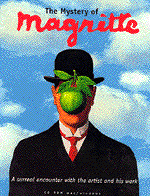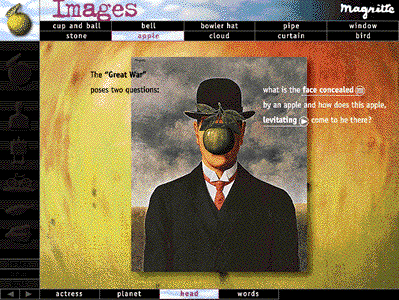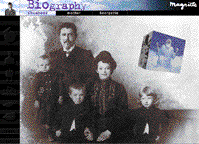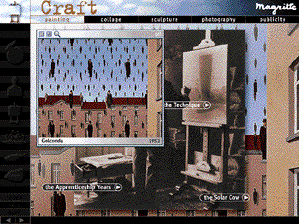Review: The Mystery of Magritte

 Product Information
Product Information
Distributed by: Harry N. Abrams, Inc.
and Byron Press Multimedia Company Inc.
Phone: (800) 945-3155
Street Price: $30 US
System Requirements
Macintosh with 68040 processor or Power Macintosh
13" or larger colour monitor
8 MB RAM
2x CD-ROM drive or greater
System 7.0 or later
When I hear the phrase, "The Man in the Black Bowler Hat," I think of Agatha Christie's fictional detective Hercule Poirot, or the Belgian artist Rene Magritte (1898-1967). The CD-ROM, "The Mystery of Magritte," produced by VIRTUO, presents a beautifully crafted journey through the life, philosophy, and visual works of the illusive hero of Surrealism, a twentieth century artistic movement. People interested in visual arts will usually associate Salvador Dali with the Surrealist style. I tend to think that Dali was the Warhol, or populist, of the movement. On the other hand, the more reclusive Magritte could be seen as the da Vinci, or intellectual, of this style.
This multimedia presentation offers, for your puzzlement, over three hundred paintings, drawings, illustrations, and photographs by Magritte. Various videos of Magritte, voice-overs, quotations, and interactive opportunities serve to enhance what I found to be a very strange journey through an alternate reality. The experience is further enhanced by a musical soundtrack that balances disturbing overtones with mysteriously eerie, haunting counterpoints.
At the risk of getting too academic, it is important to realize that Magritte's works of art are puzzles. They are meant to be pulled apart in order to discover an underlying meaning. Hold on tight for a brief trip through "semiotics," or the language of communication. I promise it won't hurt! Magritte uses "iconic signs:" a pipe, tree, leaf, and so forth, as visually real "hooks" to grab your attention and interest. That's superficially fine until you realize, with a start, that all is not as it should be! Magritte is a master of "symbolic signs." These signs are enigmatic and not easily decoded. He invites you to cross the boundary between that which is beautiful and that which is thoughtful.
Upon start-up, the CD-ROM directs you to a main menu consisting of six categories. "Images" leads you to the main iconic signs in Magritte's work. The pipe, apple, clouds, and the trademark bowler hat are among five or six other objects which continually recur in Magritte's visuals. Normally, one would think such a limited visual vocabulary would tend to generate redundant and repetitive imagery. This is
not the case. Surprises abound as the singular and combined images evolve and dissolve depending upon their contexts, scale, and relationships. A simple bell, associated with childhood innocence, becomes an eye, UFO, or other sign. Throughout the CD, thumbnail pictures can be activated to give an enlarged screen size picture. Occasionally, a narration offering some guidance for interpretation is available. Hyperlinks to the other five "Chapters" add to the unexpected surprise. Magritte would have approved. The production appears as one large labyrinth where you transport to a new vista, only to wish you could retrace your steps back to the initial screen.

"Biography" offers valuable insight into Magritte's life: the significance of his mother's suicide and the influence of Georgette, Magritte's wife, model, and muse. There are some rather strange and bizarre anecdotes which had a tangible effect on Magritte's visual imagery. Some of his images portray: a young boy who loved to run around his apartment walls with his feet never touching the ground; a child who insisted on crossing himself twenty times before dinner; or a household maid afraid to be in the same room as the young Rene. These images leave the impression that his was not the world of Beaver Cleaver.
 One interesting aspect of Magritte'sbiography is the balance created by the inspiration and support of Georgette juxtaposed with the devastating suicide of his mother when Magritte was only twelve years old. These checks and balances keep Magritte's work from becoming too intro-spective, melancholic, or depressing. The details buried in this "Chapter" are as intriguing as European film noir.
One interesting aspect of Magritte'sbiography is the balance created by the inspiration and support of Georgette juxtaposed with the devastating suicide of his mother when Magritte was only twelve years old. These checks and balances keep Magritte's work from becoming too intro-spective, melancholic, or depressing. The details buried in this "Chapter" are as intriguing as European film noir.
"Craft" allows Magritte to discuss the technique and processes he used in the variety of media he chose to express his enigmatic messages. These media include painting, collage, sculpture, photograph, and publicity. The latter is of interest as it links Magritte to Andy Warhol. Both artists worked, out offinancial necessity, in advertising and graphic design in their youths, a background which gave both men a powerful and energetic base for their work outside the field of commerce.

"Surrealism" describes the milieu within which Magritte worked, including references to artists suchas Dali. This style of visual art stressed freedom from the control of reason and linear thinking. Aesthetic and moral concerns were tossed out of the window. The process was inspired by change, play, the subconscious, the spirit of childhood, and ultimately, for Magritte, THE PUZZLE. Initially, the movement hoped to change society and the world.

"Combination of Images" provides an intriguing demonstration of Magritte's dictum that "...a good image never stands alone." He was a master at visually manifesting concepts described by strange terms as "synecdote," "hypallage," "metonymy," and "syllepsis." If those words and their meanings boggle the brain, don't attempt the The New Yorker's crossword puzzle!

"Words and Images" reinforces the idea that Magritte's works consist of, "Vignettes of language and realty locked in mutual cancellation...If some part of the world can be shown to be irrational but coherent, Magritte's work argues...nothing is certain." (Hughes, R., Shock of The New, BBC, 1980). Magritte's "Academic Illusionism" and "Magic Realism" consistently used contradictory juxtapositions of elements or events that normally did not belong together. In his world, he pushed real space and events against spatial illusion and fantasy. One delightful feature to this "Chapter" is the opportunity to guess the titles of several Magritte paintings.

In "Words and Images," you can search for images by title, criteria, date, or keyword. Images that match the query are called up for you to examine. There is an extensive bibliography and Help section, offering a narrated description of the CD-ROM contents and the basic navigational guides.
This production should not be taken lightly. Be prepared for hours of reflection, bewilderment, entertainment, and education. Any of the thumbnail pictograms can be enlarged to full screen size. The resolution is good at all stages. The video clips featuring Magritte are engaging. Their presentation in
black and white Quicktime format is a subtle reminder that Magritte was fascinated by the early cinema melodramas and silent films of the 1920's.
In previous reviews, I have often mused about whether I favour print or electronic media for dissemination of information and education. In this instance, I can state with no hesitation that I would recommend this CD-ROM over any printed book on the life, work, and processes of Rene Magritte. I got more than my money's worth; an educational experience beyond my expectations. This CD-ROM is a must have for any art lover and a nice addition to the collection of anyone who enjoys an intriguing and thought provoking journey.
Copyright ©1998 Robert Madill, <rmadill@atpm.com>. Mr. Madill is a![]() Professor of Art and Architectural History on the faculty of Architecture at
Professor of Art and Architectural History on the faculty of Architecture at
the University of Manitoba in Winnipeg, Manitoba.
Reader Comments (7)
DLN - Empire Of Light
Surrealism and Symbolism by Artist Josh Neuman
Add A Comment